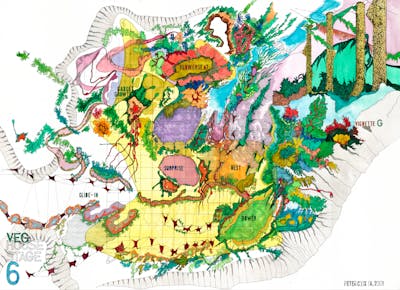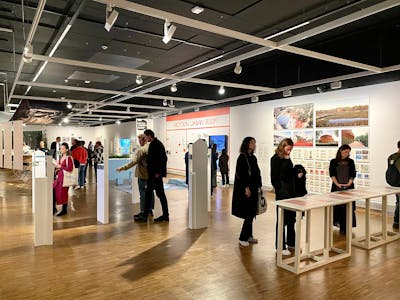Peter Cook: Urban visions and Oslo explorations
The acclaimed British architect and his Norwegian partner reflect on the cluster of happenings we call Oslo

Cook Haffner Architecture Platform (CHAP) contributes to the triennale with drawings and interventions that show how to form a more playful and surprising framework for everyday life.

Layer City Detail (1981). Image: Peter Cook.
Exploring and inventing for the city of Oslo
"Oslo is layer-by-layer: side-by-side. It is not locked into something fixed, but becoming something that might be quite different from what we are familiar with", states Erlend Blakstad Haffner, partner in CHAP (Cook Haffner Architecture Platform). Cook and Haffner contribute to the triennale with a series of drawings exhibited at the Old Munch Museum that puts Oslo into new perspectives.
Haffner continues: "Oslo har has developed exponentially from being quite a small city at the tip of the Fjord to a sophisticated and highly technologized conurbation. The story is ongoing – with the potential of architecture as a tool constantly opening up. Oslo has space, but how do we avoid that the infilling of that space doesn't fall into the trap of hasty, matter-of-fact, lowest-common-denominator thinking that characterises most of its peers?"
From main street proposals to water arcades
CHAPs exhibition at the Old Munch Museum is centred on Peter Cook's drawings that invent new city forms, and the ways in which natural landscape and building/vegetation hybrids can contribute to the future of the enjoyable city. Alternative ideas for the city are applied to neighbourhoods of Oslo, showing how imagination and technology can add urban opportunities – and can make the environment a more playful and surprising framework for life.
"We look at what is a meeting-place, a street-corner, a refuge, a studio, a workshop, a garden, a pub, a game and places of non-boredom of all kinds"
Erlend Blakstad Haffner, partner CHAP
In the work ‘PC on Paper’ there are studies for the western downtown area behind main street Karl Johans gate in which the tradition of lanterns and the "funkis"-taste for colour (based upon the flora of the plateau north of Oslo) is extended. Another visionary projects extends the bridges of the eastern harbour into a combination of ‘water-arcades’ and student housing.

Urban Retreat (2018). Image: Peter Cook.
The production city
For Oslo Architecture Triennale CHAP extends its attention to the ways in which communities and proto-communities can be generated and enlivened. Following upon the nuances of the ‘on paper’ projects, the nurturing of nature and its integration with the idea of ‘city’ is applied to these studies.
"It will emerge that these considerations cannot exist in a vacuum: the studies will demonstrate ways which the formal and material propositions are the product of new ways of thinking about building and architectural practices. Community participation runs hand-in-hand with new fabrication technologies.", states Haffner. "We need to look again at the small craft industries, the little local brick industries, the timber-working tradition and the boat-building tradition and interweave these together with the latest, the fastest, the wittiest methodology of the digital world. We look at what is a meeting-place, a street-corner, a refuge, a studio, a workshop, a garden, a pub, a game and places of non-boredom of all kinds."
The exhibition of Peter Cook's drawings is made possible thanks to a collaboration with Louisiana Museum of Modern Art.

Peter Cook and Erlend Blakstad Haffner. Photo: Pooya Aledavood.
CHAP
Sir Peter Cook and Erlend Blakstad Haffner are the founding partners of CHAP, Cook Haffner Architectural Platform. With offices in London, Oslo, Belgrade, Colombo and Shenzhen the platform represents a wide stability and starting point for future action and their ongoing projects in Europe, Brazil, the Middle East and Asia.
The platform is a fundament for creating the ever New - where the architectural project, with its elements tending to last in space and change over time, is just a base for upcoming research. CHAP encourages an experimental approach in architectural discourse, using innovative design tools and methodologies. The focus of the research is placed on architectural moments and atmospheres, implying movement and change as a constant. The platform opposes spatial borders and tends to push the boundaries of established architectural practice.


